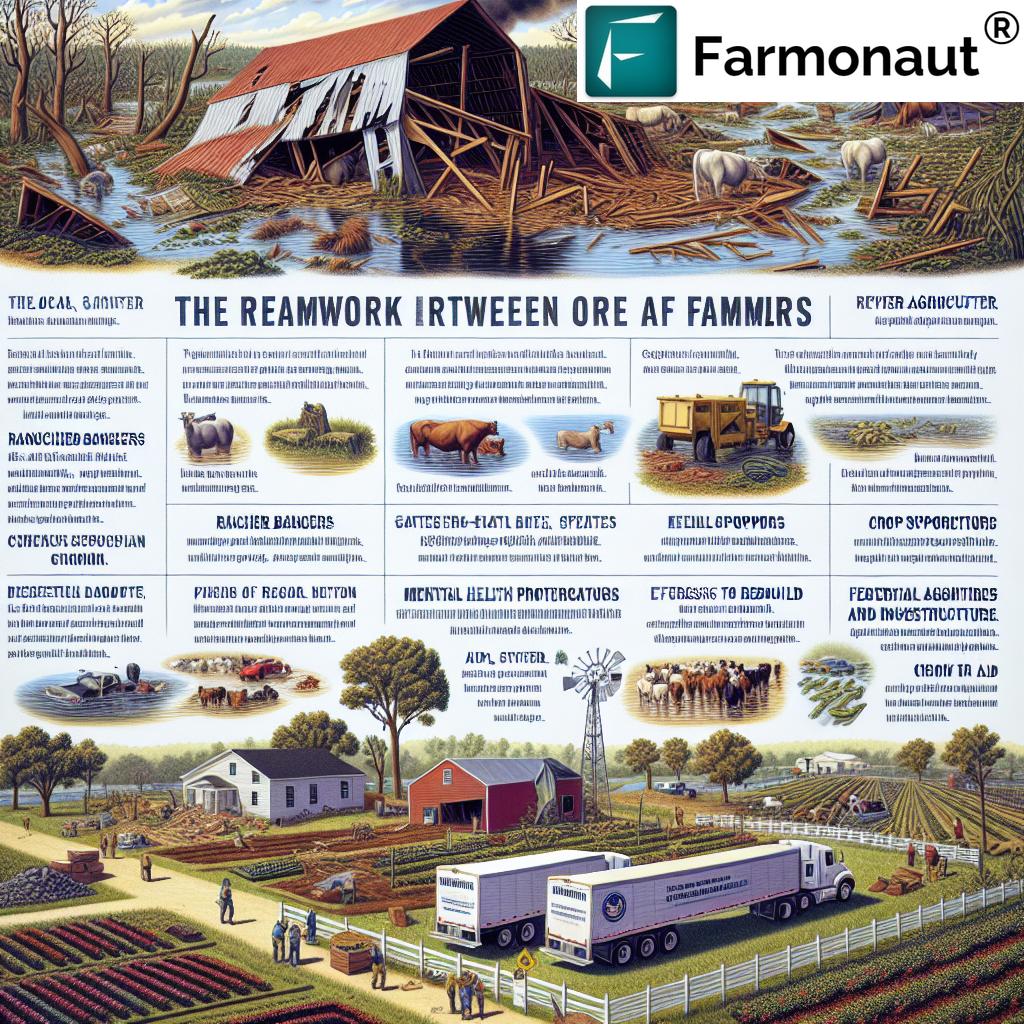Table of Contents
- Introduction
- The Impact of Hurricane Helene on North Carolina Agriculture
- FEMA’s Role in Agricultural Recovery and Disaster Assistance
- Agricultural Recovery Fairs: Addressing Agricultural Needs
- Support and Services Offered at the Fairs
- Recovery Assistance Overview Table
- Extension’s Vital Role & Local Solutions
- Addressing Livestock and Feed Challenges
- State Legislative Support & Relief Packages
- Looking Ahead: Sustainable Recovery and Resilience
- How Farmonaut Supports Modern Agricultural Management
- Frequently Asked Questions
“Over 500 North Carolina farmers received disaster assistance at FEMA Agricultural Recovery Fairs after Hurricane Helene in 2018.”
FEMA Agricultural Recovery Fairs in NC Aid Hurricane Helene Farmers
In September 2024, Hurricane Helene swept through North Carolina, unleashing catastrophic flooding and destruction upon one of the United States’ most important agricultural regions. Our farming community—the backbone of North Carolina’s economy—bore the brunt of the hurricane’s wrath, suffering massive losses in crops, livestock, facilities, and critical infrastructure. In the aftermath of such a relentless storm, quick and coordinated disaster response is vital. That’s where FEMA Agricultural Recovery Fairs in North Carolina became a beacon of hope, delivering hurricane relief for farmers and tailored support to address the challenges the agriculture sector faced.
In this comprehensive guide, we explore how North Carolina agricultural recovery events are revolutionizing post-disaster aid, examine the multi-agency response, shine a light on crucial relief programs, and highlight the evolving support landscape that ensures our agricultural sector is not only rebuilt but poised for future resilience. We also discuss innovative solutions like Farmonaut’s digital farm management platform, offering precision agriculture tools that extend the capabilities of local growers well into the future.
The Impact of Hurricane Helene on North Carolina Agriculture
The impact of Hurricane Helene on our North Carolina agriculture was both immediate and deep-rooted. As floodwaters inundated vast acreage, fields of soybeans, corn, and tobacco were destroyed, and supply chains ground to a halt. Farmers faced the horror of lost livestock, compromised facilities, and a daunting need to recover equipment and reestablish their operations.
- Extensive flooding across major agricultural counties including McDowell, Henderson, Buncombe, and Watauga
- Over $53 billion in damages statewide, with agriculture taking a disproportionate share (AP News Source)
- Immediate and long-term challenges for farmers, ranchers, nursery owners, vineyard operators, honeybee growers, and fish producers
- Significant livestock and crop damage with unique, location-specific needs for recovery
For our community, the aftermath meant not only physical devastation but uncertainty for the future. Rebuilding necessitated emergency support for ranchers, restoration of damaged infrastructure, and technical, mental, and financial assistance on an unprecedented scale.
FEMA’s Role in Agricultural Recovery and Disaster Assistance
The Federal Emergency Management Agency (FEMA) recognized the urgency and the unique challenges facing agriculture in North Carolina following Hurricane Helene. By mobilizing coordination at all levels, FEMA set out to ensure that disaster assistance would be fast, fair, and tailored directly to the needs of affected farmers.
- FEMA Agricultural Recovery Fairs North Carolina: Central strategy for streamlined, one-stop post-hurricane recovery
- Information Access: Guidance on eligibility, documentation, and specific programs
- Emergency Response: Rapid setup of recovery centers and events in the most severely damaged counties
- Coordination with USDA, SBA, and State Agencies: Alignment across federal, state, and local providers for maximum impact
The FEMA Recovery Fairs quickly became a lifeline for hundreds of North Carolina farmers—giving us not just material support, but clarity in a time of confusion and loss.
Agricultural Recovery Fairs: Addressing Hurricane-Related Needs and Challenges
The agricultural recovery fairs held in North Carolina after Hurricane Helene exemplify a problem-solving approach to disaster assistance programs for agriculture. These were more than mere distribution points; they were collaborative events designed to address the full spectrum of storm impacts on the sector.
-
Locations: First fairs held in McDowell, Henderson, Buncombe, and Watauga counties (January 2025); followed by Mitchell, Burke, Avery, and Yancey counties (February 2025).
These counties were strategically selected for being among the most severely affected. - Participants: Farmers, ranchers, nursery owners, fish producers, vineyard operators, and more.
- Format: One-day, in-person events streamlining access to disaster resources, federal programs, and expert guidance.
- Support Scope: Livestock, crops, equipment, infrastructure damages, operational continuity, and mental health support for farmers.
By bringing multiple agencies together in a single location, these fairs fast-tracked the response, giving comprehensive help where it was needed most.
Support and Services Offered at the North Carolina Agricultural Recovery Fairs
At each recovery fair, participants were not just passive recipients of aid; they engaged with specialists to identify tailored resources and problem-solving strategies for their operations. Here’s what was available on site:
- FEMA: Disaster assistance application support, claims process help, and explanation of programs relevant to agricultural loss
- USDA: Access to financial assistance and relief options—including Emergency Loans, Livestock Indemnity Program, and technical guidance
- NC Department of Commerce and Agriculture: Advice on state and local resources for rebuilding agricultural infrastructure after disaster
- SBA (U.S. Small Business Administration): Loan opportunities for farmers and agribusinesses targeting rebuilding, equipment, and operational continuity
- Extension & Local Agencies: Educational materials, referrals, mental well-being outreach, and distribution of emergency supplies
All attendees were strongly encouraged to bring documentation of ownership, damaged equipment, and proof of loss to streamline applications for relief.
“FEMA Recovery Fairs in NC offered tailored support to farmers from 10 hurricane-impacted counties in a single event.”
Recovery Assistance Overview Table: Programs, Support, and Reach
| Recovery Assistance Program | Estimated Number of Farmers Assisted | Type of Support Provided | Estimated Impact |
|---|---|---|---|
| FEMA Individual Assistance | 350+ | Emergency disaster funds, housing, crop/livestock loss aid, application guidance | $12M+ distributed; immediate housing and recovery for most affected families |
| USDA Emergency Loans & LIP | 240+ | Low-interest loans, livestock indemnity, technical advisory | 2,400+ acres; 800+ livestock units replaced/compensated |
| NC Department of Agriculture Programs | 120+ | Grants for rebuilding, local extension support, economic recovery | 40+ facilities repaired, 120+ resource packs distributed |
| Small Business Administration (SBA) Loans | 70+ | Loan applications, business restart, equipment replacement | $9M+ approved, 60+ operations restarted |
| NC Cooperative Extension Distribution | 300+ | Feed, seed & supplies; mental health support; pasture restoration | Thousands of lbs of feed and 30k lbs seed distributed |
| Local County-Specific Recovery Initiatives | Variable | Direct counseling, local debris cleanup, priority response | Fast-tracked restoration in hardest-hit zones |
Extension’s Vital Role & Local Solutions in North Carolina Agricultural Recovery
No agricultural recovery can succeed without robust local engagement. Across North Carolina, the Cooperative Extension Service was pivotal—mobilizing agents who drove out animal feed, set up distribution centers, and stood beside farmers and ranchers through every decision and challenge.
- Animal Feed & Supply Distribution: Drive-through centers in Avery and other counties made resources easily accessible (NCSU Extension)
- Pasture Restoration & Erosion Control: Distribution of cover crop seeds to restore soil and revive damaged pastures
- Mental Health Support for Farmers: Extension agents provided direct outreach and connected community members to counseling and stress relief programs
The crisis highlighted the importance of not just financial or infrastructural resources, but also of social and mental well-being in disaster zones.
Addressing Livestock and Feed Challenges: Post-Hurricane Helene
Hurricane-linked livestock and crop damage presented some of the most urgent challenges for farmers in North Carolina. Fields meant for grazing were ruined, hay barns were flooded, and emergency sources for feed and water became critical.
- Pasture & Feed Analysis: Extension specialists guided us to document every loss, work with local Farm Service Agency (FSA) offices, and pursue damage reimbursements (NCSU Disaster Response)
- Nutritional Management: Advice on immediate and long-term feeding strategies, including substituting for lost hay, and monitoring water/forage safety
- Animal Health Support: Agents provided expert veterinary contact points and public health warnings regarding water contamination, mold, and feed quality
The approach was comprehensive, pairing disaster grants with day-to-day dietary and animal health management solutions, and ensuring local resource streams stayed open.
State Legislative Support & Relief Packages in North Carolina
Alongside federal relief efforts, the North Carolina legislature moved swiftly by passing significant relief packages targeting both short-term and long-term recovery for affected farmers.
- $465 Million State Relief Package: Grants for farmers and businesses, debris removal, bridge and school repair (AP News)
- $524 Million Additional Recovery: Focus on infrastructure repair, rebuilding, and economic sustainability (AP News)
- Addressing $53 Billion in Damage: Ongoing allocation of resources as the scope of recovery continues to be assessed (AP News)
Such comprehensive packages are crucial for the sector’s long-term sustainability.
Looking Ahead: Building Resilience and Sustainable Growth After Disaster
The process of rebuilding agricultural infrastructure after disaster is a marathon, not a sprint. State, federal, and local agencies continue to innovate in delivering hurricane relief for farmers, while also fostering a culture of preparedness and sustainability throughout the North Carolina agricultural community.
- Continued monitoring, technical support, and educational outreach for affected counties
- New partnerships for disaster risk reduction and climate resilience
- Increasing reliance on precision agriculture and technology-driven management for better planning and faster response
State and emergency management agencies stress the importance of future-proofing by integrating new technologies and fostering communication between all stakeholders. This progressive mindset positions North Carolina farmers not just as survivors, but as leaders in rural disaster response and sustainable growth.
How Farmonaut Supports Modern Agricultural Management, Recovery, and Innovation
While community action and traditional disaster assistance programs for agriculture remain essential, advanced digital platforms like Farmonaut are transforming the way farmers monitor, manage, and rebuild after disaster.
-
Satellite-Based Crop Health Monitoring: Farmonaut delivers satellite imagery to your phone or browser, helping farmers assess flood impact on North Carolina farms, detect stress points in crops, and manage resources efficiently—vital for quick disaster damage detection.
Related Solution:
Agro Admin App – Scalable Farm Management enhances plantation oversight for both individual growers and large agribusinesses. - AI-Based Advisory (Jeevn AI): Receive real-time, tailored crop management and weather forecasts—helping you make data-driven decisions, right when storm or drought threatens your operation.
-
Blockchain Traceability: Increase trust and transparency in your supply chain by validating every shipment and product origin with Farmonaut’s blockchain technology.
Explore Here: Product Traceability for Agriculture -
Fleet and Resource Management: Farmonaut guides efficient deployment and management of your farming fleet—especially during emergency support for ranchers and equipment relocation phases.
Learn More: Fleet Management Solutions for Agriculture -
Carbon Footprinting: Measure the environmental impact of your operations, track carbon emissions related to disaster recovery, and progress towards greener, more sustainable farming.
See Details: Farmonaut Carbon Footprinting Platform -
Crop Loan and Insurance Support: Farmonaut partners with financial service providers to verify farm status remotely and support crop insurance, reducing fraud and speeding up payouts for storm-related claims.
How it Helps: Farmonaut Crop Loan & Insurance Verification
Accessibility: These features are available across Web, Android, iOS, and API platforms for farmers of all scales. If you’re a developer or agri-researcher, explore Farmonaut’s Satellite & Weather Data API with comprehensive Developer Documentation.
Farmonaut Subscription Options
Experience affordable, scalable farm management. Explore the latest pricing and packages:
Frequently Asked Questions (FAQ)
These are one-day in-person events, strategically held in disaster-impacted counties post-hurricane. Farmers, ranchers, and agribusinesses gain direct access to federal, state, and local resources; receive application guidance for disaster assistance programs; and get expert, tailored support to recover from agricultural challenges.
Who can attend the Agricultural Recovery Fairs?
Farmers, ranchers, nursery owners, vineyard operators, honeybee growers, fish producers, and local agribusinesses in the hurricane-affected counties can participate—regardless of farm size.
What types of support are available?
Support includes financial assistance, technical guidance, aid for lost/damaged livestock and crops, supplies distribution (feed, cover crop seeds), mental health outreach, and information on farm rebuilding and insurance options.
How does Farmonaut support North Carolina agricultural recovery?
Farmonaut provides real-time crop health monitoring, data-driven farm management, and disaster assessment tools via web/mobile/API. These help farmers and agencies quickly identify damage, plan resource allocation, and monitor recovery activities efficiently and affordably.
Where can I access Farmonaut’s solutions?
Farmonaut’s platform is accessible via Web App, Android, and iOS. For integration, use the API.
How is mental health support for farmers addressed?
Local extension agents and agencies prioritize mental health, offering counseling outreach, stress resources, and regular check-ins at recovery fairs and community gatherings.
What documentation do I need to apply for disaster aid at a fair?
Bring proof of farm ownership, loss/damage photos, equipment lists, and any insurance documentation to expedite the disaster assistance application process.
Conclusion: Collaboration, Innovation, and Resilience Drive North Carolina’s Recovery
The experience of Hurricane Helene taught us the power of collaborative action and the necessity for tailored, rapid problem-solving in agricultural recovery. The FEMA Agricultural Recovery Fairs in North Carolina unite diverse agencies, deliver actionable resources, and offer holistic care for the mental and operational health of our farmers.
At the same time, innovative technology solutions—such as precision analysis, resource management, and traceability platforms—are helping us rebuild faster and with greater resilience. Farmonaut’s commitment to accessible, data-driven agriculture empowers our community to thrive, no matter the storm.
We encourage all North Carolina farmers and stakeholders to discover the latest in agricultural monitoring, support, and relief tools—and to remain as connected, prepared, and forward-thinking as possible.
Stay informed, stay resilient, and let’s keep moving North Carolina agriculture forward—together.






















